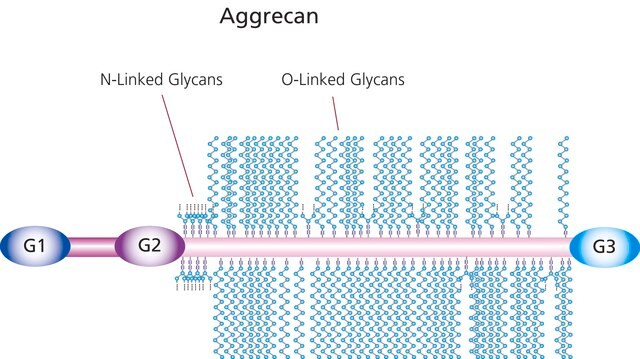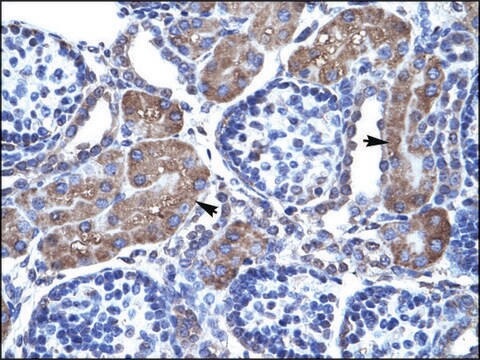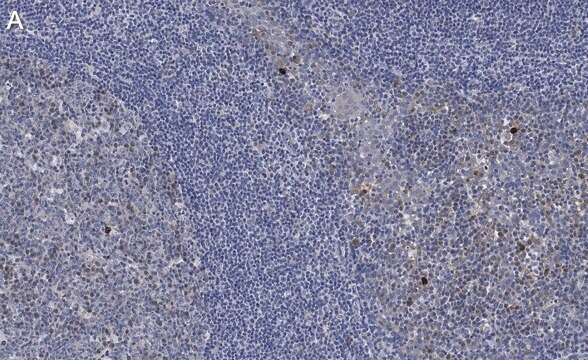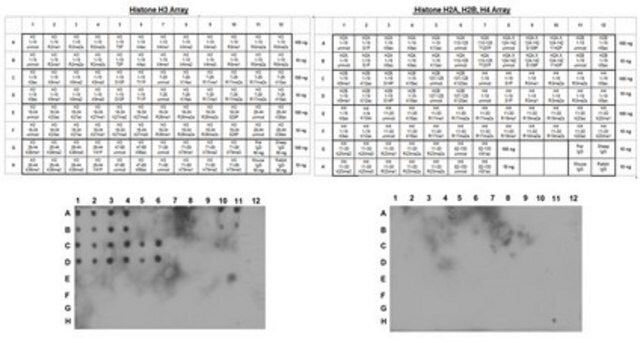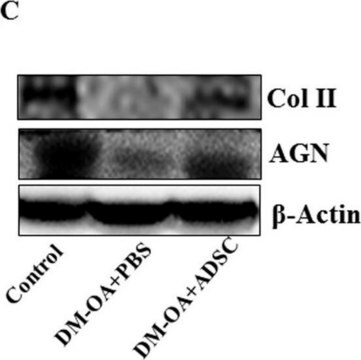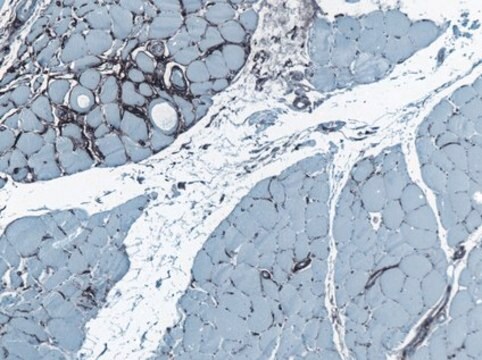CC1890
Aggrecan Interglobular Domain, Recombinant, His-tagged
Sinônimo(s):
Aggrecan-IGD1
Faça loginpara ver os preços organizacionais e de contrato
About This Item
Código UNSPSC:
12352204
eCl@ss:
32160405
NACRES:
NA.77
Produtos recomendados
fonte biológica
human
Nível de qualidade
Formulário
liquid
fabricante/nome comercial
Chemicon®
nº de adesão NCBI
nº de adesão UniProt
Condições de expedição
dry ice
Informações sobre genes
human ... ACAN(176)
Descrição geral
Aggrecan is a large aggregating proteoglycan of articular cartilage. It is also found in aorta, discs and tendons [Knudsen & Knudsen, 2001; Watanabe et al., 1998]. The aggrecan core protein consists of 2317 amino acids [Watanabe et al., 1998]. Up to 130 glucosaminoglycan chains are attached to the core protein and the total molecular mass can reach 2.2 - 3.0 x 106 Daltons [Hardingham & Fosang, 1992]. Within the aggrecan molecule 3 global domains G1, G2 and G3 can be distinguished. Domains G1 and G2 are connected by a rod-shaped polypeptide called interglobular domain (IGD), while the sequence between domains G2 and G3 contains attachment regions for keratan sulfate and chondroitin sulfate chains. Aggrecan interacts via the G1domain with hyaluronan and link protein to form large aggregates. Such aggregates can contain up to 50-100 aggrecan monomers noncovalently bound to a single hyaluronan chain through 2 link proteins [Knudsen & Knudsen, 2001; Watanabe et al., 1998; Hardingham & Fosang, 1992]. The aggregates form a hydrated gel-like structure, which endowes cartilage with resistibility to compression and deformation. Degradation of aggrecan appears to initiate at the C-terminus. The population of aggrecan molecules without the G3 domain increases with aging [Dudhia et al., 1996]. Isolated aggrecanases cleave aggrecan at 4 sites within the chrondroitin sulfate-rich region (sites E1667 -G1668, E1480-G1481, E1771 - A1772, E1871 - L1872) and 1 site within the interglobular domain (E373 - A374) [Tortorella et al., 2000]. Cleavage at the latter site had been documented by analysis of cartilage proteoglycan breakdown products in rheumatoid and osteoarthritis [Lohmander et al., 1993]. To measure aggrecanase activity, an artificial recombinant protein composed of aggrecan interglobular domain with flanking FLAG-sequence and human immunoglobulin G1 constant region was first used by Hughes et al. [Hughes et al., 1997].
Molecular form: The polypeptide connecting human aggrecan globular domains 1 and 2 (T331 - G458) is expressed in E. coli with a C-terminal twin His-tag {6His-L-E-6His}. The recombinant protein contains cleavage sites for aggrecanases (E373 - A374) and matrix metalloproteinases (N341 - F342). It comprises the following amino acids: T A E D F V D I P E N<> F F G V G G E E D I T V Q T V T W P D M E L P L P R N I T E G E <>A R G S V I L T V K P I F E V S P S P L E P E E P F T F A P E I G A T A F A E V E N E T G E A T R P W G F P T P G L G P A T A F T S E D L V V Q V T A V P G Q P H L P G G (His-tag)
Main cleavage sites are indicated by <> inclusions.. The calculated Mr of the His-tagged protein is 15,493 Da.
Purity: The recombinant aggrecan interglobular domain appears as a major band at about 21 kDa in SDS-PAGE. It represents more than 90% of total protein in the preparation.
Applications: Aggrecan interglobular domain is used as substrate for aggrecanases and matrix metalloproteinases. For proteinase activity measurements, the protein is incubated with proteinase for various time intervals. Thereafter, aliquots of the incubation mixture are analyzed by SDS-PAGE or by ELISA.Upon cleavage with aggrecanases the apparent Mr of aggrecan interlobular domain in SDS-PAGE is reduced from 21 kDa to about 13 kDa. Quantitative measurement of aggrecanase cleavage requires a neoepitop antibody with specificity for the N-terminus A R G S V I L T . . . appearing upon hydrolysis. The fragment with the newly formed N-terminus is fixed by the neoepitop antibody to a microplate and quantified with an anti-His-tag antibody. In analogy, cleavage by matrix metalloproteinases can be measured with antibodies to neoepitopes appearing upon action of these enzymes.
Main cleavage sites are indicated by <> inclusions.. The calculated Mr of the His-tagged protein is 15,493 Da.
Purity: The recombinant aggrecan interglobular domain appears as a major band at about 21 kDa in SDS-PAGE. It represents more than 90% of total protein in the preparation.
Applications: Aggrecan interglobular domain is used as substrate for aggrecanases and matrix metalloproteinases. For proteinase activity measurements, the protein is incubated with proteinase for various time intervals. Thereafter, aliquots of the incubation mixture are analyzed by SDS-PAGE or by ELISA.Upon cleavage with aggrecanases the apparent Mr of aggrecan interlobular domain in SDS-PAGE is reduced from 21 kDa to about 13 kDa. Quantitative measurement of aggrecanase cleavage requires a neoepitop antibody with specificity for the N-terminus A R G S V I L T . . . appearing upon hydrolysis. The fragment with the newly formed N-terminus is fixed by the neoepitop antibody to a microplate and quantified with an anti-His-tag antibody. In analogy, cleavage by matrix metalloproteinases can be measured with antibodies to neoepitopes appearing upon action of these enzymes.
Product Source: Human
forma física
The calculated Mr of the His-tagged protein is 15,493 Da. The protein is solubilized in 50 mM Tris-HCI, pH 7.5, 150 mM NaCl, 5 mM CaCl2.
Armazenamento e estabilidade
MT5-MMP is stable until the expiry date given on the label of stored at -70°C. The protein can be kept at -20°C for several weeks and on ice for several days. Repeated freezing and thawing should be avoided.
Informações legais
CHEMICON is a registered trademark of Merck KGaA, Darmstadt, Germany
Exoneração de responsabilidade
Unless otherwise stated in our catalog or other company documentation accompanying the product(s), our products are intended for research use only and are not to be used for any other purpose, which includes but is not limited to, unauthorized commercial uses, in vitro diagnostic uses, ex vivo or in vivo therapeutic uses or any type of consumption or application to humans or animals.
Código de classe de armazenamento
12 - Non Combustible Liquids
Classe de risco de água (WGK)
WGK 1
Ponto de fulgor (°F)
Not applicable
Ponto de fulgor (°C)
Not applicable
Certificados de análise (COA)
Busque Certificados de análise (COA) digitando o Número do Lote do produto. Os números de lote e remessa podem ser encontrados no rótulo de um produto após a palavra “Lot” ou “Batch”.
Já possui este produto?
Encontre a documentação dos produtos que você adquiriu recentemente na biblioteca de documentos.
C B Knudson et al.
Seminars in cell & developmental biology, 12(2), 69-78 (2001-04-09)
The predominant proteoglycan present in cartilage is the large chondroitin sulfate proteoglycan 'aggrecan'. Following its secretion, aggrecan self-assembles into a supramolecular structure with as many as 50 monomers bound to a filament of hyaluronan. Aggrecan serves a direct, primary role
Nossa equipe de cientistas tem experiência em todas as áreas de pesquisa, incluindo Life Sciences, ciência de materiais, síntese química, cromatografia, química analítica e muitas outras.
Entre em contato com a assistência técnica

